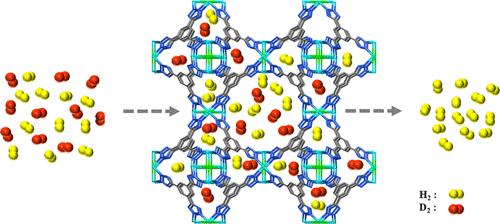具有开放金属位的金属-有机骨架用于D2/H2分离
IF 4.7
2区 化学
Q1 CHEMISTRY, INORGANIC & NUCLEAR
Inorganic Chemistry
Pub Date : 2025-01-08
DOI:10.1021/acs.inorgchem.4c0509510.1021/acs.inorgchem.4c05095
引用次数: 0
摘要
氢同位素的分离仍然是一个重大的挑战,因为它们几乎相同的物理化学性质。近年来,利用化学亲和量子筛分效应的金属有机骨架在氢同位素分离中受到越来越多的关注。本研究合成了具有开放金属位的Cu-BTT,对H2和D2的氢同位素吸附量分别为266 cm3/g和288 cm3/g。动态突破实验显示,Cu-BTT在77 K下的选择性为1.58,这表明Cu-BTT作为氢同位素分离的有前景的候选材料。本文章由计算机程序翻译,如有差异,请以英文原文为准。

Metal–Organic Framework with Open Metal Sites for D2/H2 Separation
The separation of hydrogen isotopes remains a significant challenge due to their nearly identical physicochemical properties. Recently, metal–organic frameworks employing the chemical affinity quantum sieving effect have garnered increasing attention for hydrogen isotope separation. In this study, Cu-BTT with open metal sites was synthesized and demonstrated high hydrogen isotope adsorption capacities of 266 cm3/g for H2 and 288 cm3/g for D2. Dynamic breakthrough experiments revealed a selectivity of 1.58 at 77 K, highlighting the potential of Cu-BTT as a promising candidate for hydrogen isotope separation.
求助全文
通过发布文献求助,成功后即可免费获取论文全文。
去求助
来源期刊

Inorganic Chemistry
化学-无机化学与核化学
CiteScore
7.60
自引率
13.00%
发文量
1960
审稿时长
1.9 months
期刊介绍:
Inorganic Chemistry publishes fundamental studies in all phases of inorganic chemistry. Coverage includes experimental and theoretical reports on quantitative studies of structure and thermodynamics, kinetics, mechanisms of inorganic reactions, bioinorganic chemistry, and relevant aspects of organometallic chemistry, solid-state phenomena, and chemical bonding theory. Emphasis is placed on the synthesis, structure, thermodynamics, reactivity, spectroscopy, and bonding properties of significant new and known compounds.
 求助内容:
求助内容: 应助结果提醒方式:
应助结果提醒方式:


